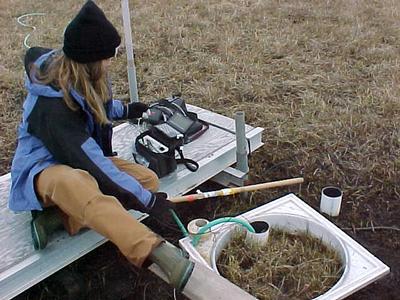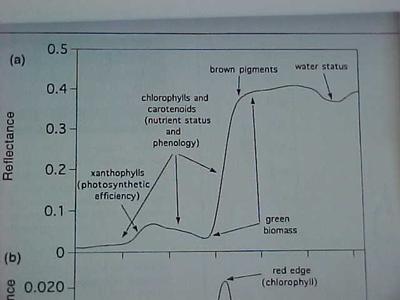27 June, 2001
Wednesday
This morning Glen and I had a conference call with 25 people some of who
were high school teachers, slated to go to the Antarctic/ Arctic this
year. Glen filled them in on his on going work and I for the most part
filled them in on the research from a teacher's perspective.
Went out to the site this afternoon to continue to count plants! We
should be done by tomorrow. I don't think I will ever forget Dupontia
frigitas for the rest of my life! The sad thing though is that it only
grows up here!
Erika was at the site taking reflectance measurement today. This is the
first time she has done this to Glen's entire site. The instrument she is
using is called a Unispec Reflectometer. While we can see (with our eyes)
that the plots are greening up, using the instrument allows us to
optically distinguish the changes in the leaf pigments over time. When
measurements are repeated, in a week, they will be relatively compared to
this week's measurement and will allow us to say, for example, that plot
1-1 is 10% greener than it was last week.
The instrument is the choice for the Cal State LA project because it is
non destructive and easy to use in the field. In the arctic, leaves are
small and do not necessarily have the size necessary for testing. This,
plus the chemical analysis time and money other alternative methods
involve, add to the convenience of using the spectrometer.
If you look at the picture where Erika is holding a wood pole over the
plot you can see a silver probe extending down from the tip. This probe
senses the light striking the plants and divides the reflected light into
wavelengths of the visible and NIR (near infrared) through a diffraction
grating in the instrument. On the instrument's screen a spectral
reflectance curve is generated and represents the light reflected off of
the plants which can then be divided into a number of indices which are
used to infer physiological properties. These spectral reflectance
curves will change through out the growing season. It is important to
note that different species, because of physiological differences, will
show varying reflectance indices and different plants growing together
will also produce different spectral reflectance indexes. Erika is
getting a measurement from each plot that will be compared to curves taken
throughout the season.
The NDVI (normalized difference vegetative index) is a relative measure,
which is mathematically derived from the red and NIR wavelengths, which
provides some measure of light absorption by photosynthetic tissues.
People use NDVI to model photosynthetic processes through time. The NDVI
assigns a number between 0 and 1 that gives you a measure of plant
greenness based on pigment content. Photosynthetic pigments, chlorophyll
being one (carotenoids and anthocyanins being others), capture solar
energy, and control light absorption for carbon uptake. NDVI is a widely
recognized index that is influenced by vegetation structure and
chlorophyll content and can be correlated with seasonal plant development.
To validate the ability of the Unispec to measure spectral reflectance one
could use other conventional, destructive, wet chemical techniques to
calibrate their results to make sure that each method does correlate with
the other. When these tests were both done the indices were strongly
correlated with area based chlorophyll content of plants, meaning the use
of the spectrometer in the field is a valid data gathering devise and
produces similar results and employs less time consuming and costly
procedures. Given this John wants to find out if the spectral data he is
collecting on his track (or anywhere in the tundra here) will correspond
to Glen's CO2 flux data and the tower flux data. To do this Erika is
monitoring each individual plot and their treatment and compiling spectral
reflectance curves for each. These will be compared to Glen's flux data
to see if reflectance and flux correlate. If changes of chlorophyll over
time can be correlated with Glen's CO2 flux data through the different
treatments then more will be known about how the tundra is involved in
carbon exchange and another indirect way of measuring flux can be
developed. The question is can you infer carbon uptake by plants from the
reflectance curves of the plant in this parcticular situation?
As we were at the site Rommel completed one of his 3 transects of the day.
He flies from Barrow to Atkasook, 60 km, about 30 feet above the ground at
all times, taking meteorological measurements and recording flux data with
the various instruments on the plane. This is the regional part of the
research project that is so important and was impossible to do up to two
years ago before the Sky Arrow was purchased. No other study of flux
takes in the large area that this one does (in km.) and that is why it is
so important.
Three separate but integral parts; Glen's flux data from a small site
perspective, Hjojung's flux data from a 400m. tower radius perspective and
Rommel's area flux data from a large section perspective all are acting to
corroborate each other's data. When all the data is compiled each portion
should paint a clearer and larger picture of what is occurring in the
arctic as far as CO2 exchange.

Erika recording reflectance measurements at Glen's site. At the end of the wood stick you can see the rod which gathers the light and directs it to a sensor inside the instrument beside her.

Field journals are important. Everything one does should be recorded in the book. They are also a good tool to use to remember what one did on any given day during the season. They stay with the project files as a back up information source.

A diagram of the spectral reflectance curve for healthy leaves.
Contact the TEA in the field at
.
If you cannot connect through your browser, copy the
TEA's e-mail address in the "To:" line of
your favorite e-mail package.
|
